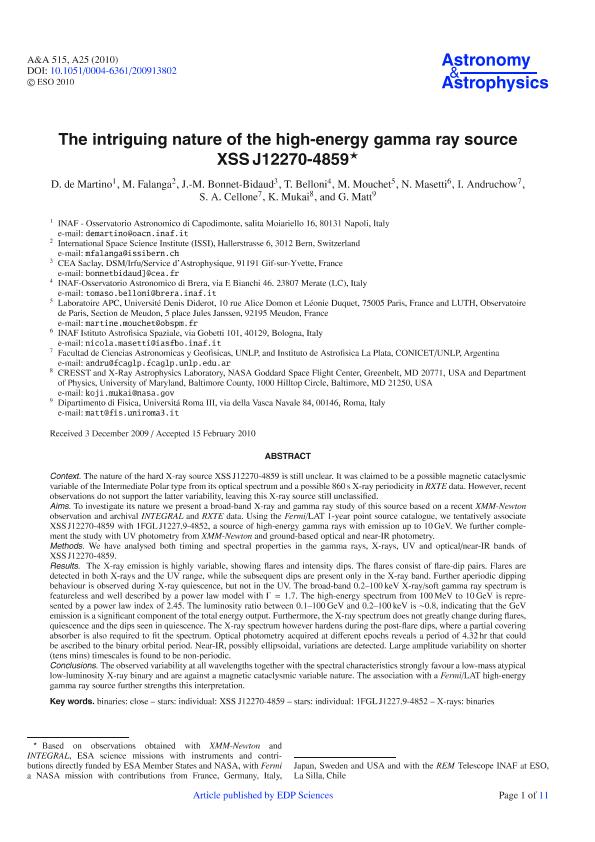Mostrar el registro sencillo del ítem
dc.contributor.author
De Martino, D.

dc.contributor.author
Falanga, M.

dc.contributor.author
Bonnet-Bidaud, J.-M.

dc.contributor.author
Belloni, T.

dc.contributor.author
Mouchet, M.

dc.contributor.author
Masetti, N.

dc.contributor.author
Andruchow, Ileana

dc.contributor.author
Cellone, Sergio Aldo

dc.contributor.author
Mukai, K.
dc.contributor.author
Matt, G.
dc.date.available
2019-02-12T16:23:25Z
dc.date.issued
2010-06
dc.identifier.citation
De Martino, D.; Falanga, M.; Bonnet-Bidaud, J.-M.; Belloni, T.; Mouchet, M.; et al.; The intriguing nature of the high-energy gamma ray source XSS J12270-4859; EDP Sciences; Astronomy and Astrophysics; 515; 6-2010; 25-36
dc.identifier.issn
0004-6361
dc.identifier.uri
http://hdl.handle.net/11336/69966
dc.description.abstract
The nature of the hard X-ray source XSS J12270-4859 is still unclear. It was claimed to be a possible magnetic Cataclysmic Variable of the Intermediate Polar type from its optical spectrum and a possible 860 s X-ray periodicity in RXTE data. However, recent observations do not support the latter variability, leaving this X-ray source still unclassified. To investigate its nature we present a broad-band X-ray and gamma ray study of this source based on a recent XMM-Newton observation and archival INTEGRAL and RXTE data. Using the Fermi/LAT 1-year point source catalogue, we tentatively associate XSS J12270-4859 with 1FGL J1227.9-4852, a source of high energy gamma rays with emission up to 10 GeV. We further complement the study with UV photometry from XMM-Newton and ground-based optical and near-IR photometry. We have analysed both timing and spectral properties in the gamma rays, X-rays, UV and optical/near-IR bands of XSS J12270-4859. The X-ray emission is highly variable showing flares and intensity dips. The flares consist of flare-dip pairs. Flares are detected in both X-rays and UV range whilst the subsequent dips are present only in the X-ray band. Further aperiodic dipping behaviour is observed during X-ray quiescence but not in the UV. The broad-band 0.2--100 keV X-ray/soft gamma ray spectrum is featureless and well described by a power law model with Gamma=1.7. The high energy spectrum from 100 MeV to 10 GeV is represented by a power law index of 2.45. The luminosity ratio between 0.1--100 GeV and 0.2--100 keV is ~ 0.8, indicating that the GeV emission is a significant component of the total energy output. Furthermore, the X-ray spectrum does not greatly change during flares, quiescence and the dips seen in quiescence. The X-ray spectrum however hardens during the post-flare dips, where a partial covering absorber is also required to fit the spectrum. Optical photometry acquired at different epochs reveals a period of 4.32 hr that could be ascribed to the binary orbital period. Near-IR, possibly ellipsoidal, variations are detected. Large amplitude variability on shorter (tens mins) timescales are found to be non-periodic. The observed variability at all wavelengths together with the spectral characteristics strongly favour a low-mass atypical low-luminosity X-ray binary and are against a magnetic Cataclysmic Variable nature. The association with a Fermi/LAT high energy gamma ray source further strengths this interpretation.
dc.format
application/pdf
dc.language.iso
eng
dc.publisher
EDP Sciences

dc.rights
info:eu-repo/semantics/openAccess
dc.rights.uri
https://creativecommons.org/licenses/by-nc-sa/2.5/ar/
dc.subject
Close Binaries
dc.subject
Xss J12270-4859 (Estrella)
dc.subject
Gamma Rays
dc.subject
X-Ray Binaries
dc.subject
Accretion Disks
dc.subject
1fglj1227.9-4852 (Estrella)
dc.subject.classification
Astronomía

dc.subject.classification
Ciencias Físicas

dc.subject.classification
CIENCIAS NATURALES Y EXACTAS

dc.title
The intriguing nature of the high-energy gamma ray source XSS J12270-4859
dc.type
info:eu-repo/semantics/article
dc.type
info:ar-repo/semantics/artículo
dc.type
info:eu-repo/semantics/publishedVersion
dc.date.updated
2019-02-12T14:51:26Z
dc.journal.volume
515
dc.journal.pagination
25-36
dc.journal.pais
Francia

dc.description.fil
Fil: De Martino, D.. Osservatorio Astronomico Di Capodimonte; Italia
dc.description.fil
Fil: Falanga, M.. International Space Science Institute; Estados Unidos
dc.description.fil
Fil: Bonnet-Bidaud, J.-M.. Cea Saclay; Francia
dc.description.fil
Fil: Belloni, T.. Osservatorio Astronomico Di Brera; Italia
dc.description.fil
Fil: Mouchet, M.. Université Paris Diderot - Paris 7; Francia
dc.description.fil
Fil: Masetti, N.. Centre National de la Recherche Scientifique. Observatoire de Paris. Laboratoire de L`univers Et Ses Theories; Francia. Inaf Istituto Di Astrofisica Spaziale E Fisica Cosmica, Bologna; Italia
dc.description.fil
Fil: Andruchow, Ileana. Consejo Nacional de Investigaciones Científicas y Técnicas. Centro Científico Tecnológico Conicet - La Plata. Instituto de Astrofísica La Plata. Universidad Nacional de La Plata. Facultad de Ciencias Astronómicas y Geofísicas. Instituto de Astrofísica La Plata; Argentina
dc.description.fil
Fil: Cellone, Sergio Aldo. Consejo Nacional de Investigaciones Científicas y Técnicas. Centro Científico Tecnológico Conicet - La Plata. Instituto de Astrofísica La Plata. Universidad Nacional de La Plata. Facultad de Ciencias Astronómicas y Geofísicas. Instituto de Astrofísica La Plata; Argentina
dc.description.fil
Fil: Mukai, K.. Nasa Goddard Space Flight Center; Estados Unidos. University Of Maryland, Baltimore; Estados Unidos
dc.description.fil
Fil: Matt, G.. Università Degli Studi Roma Tre; Italia
dc.journal.title
Astronomy and Astrophysics

dc.relation.alternativeid
info:eu-repo/semantics/altIdentifier/doi/http://dx.doi.org/10.1051/0004-6361/200913802
dc.relation.alternativeid
info:eu-repo/semantics/altIdentifier/url/https://www.aanda.org/articles/aa/abs/2010/07/aa13802-09/aa13802-09.html
Archivos asociados
